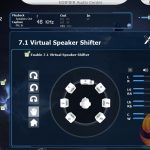To test the G4, I used it as my daily driver for one week. During this time, I used the headset while gaming, listening to music and watching videos.
Software
Note: if the above gallery is not displaying properly, please disable your adblocker as they are known to interfere with our display code.
Above you can see all the different options available in the software, and being honest, I am not impressed. Having an EQ is useful, but most of the software is junk to be completely honest – things like ‘Xear SingFX' and ‘Environment Effects' are just gimmicks that essentially just add sound effects to the audio feed.
The good news is, you don't actually need to use the software at all – in fact, the experience is much better without it, as it is essentially just superfluous nonsense.
Comfort and build quality
Moving onto comfort, the G4 isn't the comfiest headset I've ever used, but it isn't bad either. The ear cushions are bit too spongy for my liking – I'd like them to be a bit firmer – which means you can feel a bit too much clamping pressure around the sides of your head.
However, the headband is well-padded and distributes the headsets weight nice and evenly, so that is a plus.
Build quality is actually very good for the money, especially considering it is an all-plastic construction. I'm not too keen on the glossy ear cups as they are serious fingerprint magnets, but that is my only real complaint. The rest of the headset is very sturdy and that is quite impressive when we remember the G4 costs just £40.
As a point of reference, the Cooler Master MH320 costs £35, and despite incorporating a metal headband, it feels much cheaper than this Edifier G4.
Sound quality
Right off the bat, one thing becomes very clear about the G4's sound: there is very little bass, something which is actually quite surprising for a gaming headset. It is not completely missing but it is definitely recessed and is about as far from ‘powerful' as it gets.
That does mean music sounds a bit flat and lifeless – there's just no low-end energy to give any impact or ‘slam'.
However, the benefit of the overall sound signature definitely comes out when gaming. In-game audio just sounds so clear – whether you are listening out for your team mates or trying to hear the enemy's footsteps, there is great clarity to the sound.
For instance, I have been playing a lot of PUBG recently, where audio cues can really play a major role in your battle for survival. Using the G4 I was able to pick out distant gunshots, the roar of approaching cars and even the nearby footsteps of my rivals.
While we are on the topic of gaming, I should mention the virtual 7.1 surround-sound engine that can be enabled or disabled in the software. I won't mince my words – it is very poor. The clarity and detail that is present in stereo mode instantly vanishes into a big soupy mess when the virtual 7.1 is enabled – it was much easier to place in-game noises in stereo mode than with virtual 7.1 turned on, so I would strongly discourage you from using it.
One other very ‘interesting' feature is the vibration mode that is enabled by toggling the red switch on the in-line controller. This is a very bizarre function, but it seems it is designed to add some more ‘rumble' in the low-end by causing the headset to vibrate. In short, it absolutely wrecks the audio quality so I would stay well away. It is certainly novel and unique, but it is just not necessary.
Mic quality
Cutting right to the chase, here is a quick mic test of the Edifier G4:
Overall, the sound is actually very clear and is not really that nasally at all, which is certainly impressive. I do think the audio sounds a bit distant, but the clarity is definitely there and I had no issues using it with Discord's voice chat functionality while playing PUGB. With the G4 being a USB headset, too, there is no EMI interference to worry about either.
 KitGuru KitGuru.net – Tech News | Hardware News | Hardware Reviews | IOS | Mobile | Gaming | Graphics Cards
KitGuru KitGuru.net – Tech News | Hardware News | Hardware Reviews | IOS | Mobile | Gaming | Graphics Cards














